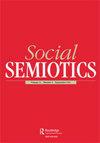The battle for 5Pointz and signifying regimes: desirable subjects, hierarchies of value, and legitimizing state power
IF 1.2
2区 文学
Q2 COMMUNICATION
引用次数: 2
Abstract
ABSTRACT This article offers an analysis of semiotic regimes that accompanied the redevelopment of 5Pointz and the ensuing civil lawsuits. Located in Queens, New York, 5Pointz was a building owned by GM Realty, who allowed Jonathan Cohen to curate graffiti works on its exterior and interior walls from 2002 through to 2013. I identify the ideological significance of three semiotic regimes generated by the 5Pointz saga. First, I treat “landed capital” (property development, growth machines) and “cultural commodification” (the art world) as observing systems that were central to constructing the meaning of the 5Pointz closure and litigation. These observational vantage points relied on a dichotomous logic involving desirable and undesirable subjectivity, but located key actors in distinct ways. Second, the legal outcome was often construed as a “major victory for artists.” However, portraying the damages awarded as an unequivocal victory normalizes hegemonic constructions of value wherein the activities of capitalism’s major players are accorded more worth than any other human activity. Finally, I focus on portraying the conflict between graffiti writers and landed capital as a “David and Goliath” battle. Signifying the conflict in such a manner (mis)construes the sovereign state as an impartial actor that adjudicates between competing rights claims.5点和象征性政权之争:理想的主体、价值等级制度和国家权力合法化
摘要本文分析了伴随着5Pointz的重新开发和随之而来的民事诉讼而产生的符号制度。5Pointz位于纽约皇后区,是通用汽车房地产公司旗下的一座建筑,该公司允许乔纳森·科恩在2002年至2013年期间策划其外墙和内墙的涂鸦作品。我确定了由5Pointz传奇产生的三个符号主义政权的意识形态意义。首先,我将“土地资本”(房地产开发、增长机器)和“文化商品化”(艺术世界)视为观察系统,它们对构建5Pointz关闭和诉讼的意义至关重要。这些观察的有利位置依赖于一种二分法的逻辑,包括可取和不可取的主观性,但以不同的方式定位了关键参与者。其次,法律结果通常被解释为“艺术家的重大胜利”。然而,将赔偿金描述为明确的胜利,使霸权主义的价值建构正常化,在这种价值建构中,资本主义主要参与者的活动比任何其他人类活动都更有价值。最后,我将重点描绘涂鸦作家和土地资本之间的冲突,将其描绘成一场“大卫与歌利亚”之战。以这种方式(错误地)表明冲突将主权国家解释为在相互竞争的权利主张之间做出裁决的公正行为者。
本文章由计算机程序翻译,如有差异,请以英文原文为准。
求助全文
约1分钟内获得全文
求助全文

 求助内容:
求助内容: 应助结果提醒方式:
应助结果提醒方式:


